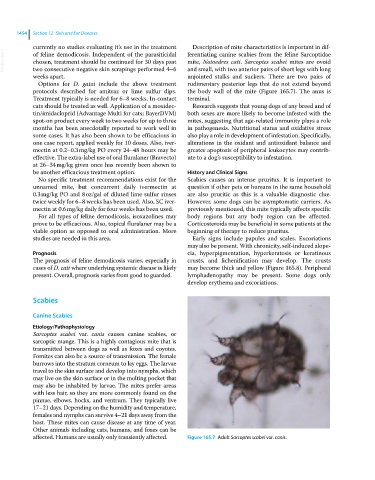Page 1516 - Clinical Small Animal Internal Medicine
P. 1516
1454 Section 12 Skin and Ear Diseases
currently no studies evaluating it’s use in the treatment Description of mite characteristics is important in dif-
VetBooks.ir of feline demodicosis. Independent of the parasiticidal ferentiating canine scabies from the feline Sarcoptidae
mite, Notoedres cati. Sarcoptes scabei mites are ovoid
chosen, treatment should be continued for 30 days past
two consecutive negative skin scrapings performed 4–6
unjointed stalks and suckers. There are two pairs of
weeks apart. and small, with two anterior pairs of short legs with long
Options for D. gatoi include the above treatment rudimentary posterior legs that do not extend beyond
protocols described for amitraz or lime sulfur dips. the body wall of the mite (Figure 165.7). The anus is
Treatment typically is needed for 6–8 weeks. In‐contact terminal.
cats should be treated as well. Application of a moxidec- Research suggests that young dogs of any breed and of
tin/imidacloprid (Advantage Multi for cats; BayerDVM) both sexes are more likely to become infested with the
spot‐on product every week to two weeks for up to three mites, suggesting that age‐related immunity plays a role
months has been anecdotally reported to work well in in pathogenesis. Nutritional status and oxidative stress
some cases. It has also been shown to be efficacious in also play a role in development of infestation. Specifically,
one case report, applied weekly for 10 doses. Also, iver- alterations in the oxidant and antioxidant balance and
mectin at 0.2–0.3 mg/kg PO every 24–48 hours may be greater apoptosis of peripheral leukocytes may contrib-
effective. The extra-label use of oral fluralaner (Bravecto) ute to a dog’s susceptibility to infestation.
at 26–34 mg/kg given once has recently been shown to
be another efficacious treatment option. History and Clinical Signs
No specific treatment recommendations exist for the Scabies causes an intense pruritus. It is important to
unnamed mite, but concurrent daily ivermectin at question if other pets or humans in the same household
0.3 mg/kg PO and 8 oz/gal of diluted lime sulfur rinses are also pruritic as this is a valuable diagnostic clue.
twice weekly for 6–8 weeks has been used. Also, SC iver- However, some dogs can be asymptomatic carriers. As
mectin at 0.6 mg/kg daily for four weeks has been used. previously mentioned, this mite typically affects specific
For all types of feline demodicosis, isoxazolines may body regions but any body region can be affected.
prove to be efficacious. Also, topical fluralaner may be a Corticosteroids may be beneficial in some patients at the
viable option as opposed to oral administration. More beginning of therapy to reduce pruritus.
studies are needed in this area. Early signs include papules and scales. Excoriations
may also be present. With chronicity, self‐induced alope-
Prognosis cia, hyperpigmentation, hyperkeratosis or keratinous
The prognosis of feline demodicosis varies, especially in crusts, and lichenification may develop. The crusts
cases of D. cati where underlying systemic disease is likely may become thick and yellow (Figure 165.8). Peripheral
present. Overall, prognosis varies from good to guarded. lymphadenopathy may be present. Some dogs only
develop erythema and excoriations.
Scabies
Canine Scabies
Etiology/Pathophysiology
Sarcoptes scabei var. canis causes canine scabies, or
sarcoptic mange. This is a highly contagious mite that is
transmitted between dogs as well as foxes and coyotes.
Fomites can also be a source of transmission. The female
burrows into the stratum corneum to lay eggs. The larvae
travel to the skin surface and develop into nymphs, which
may live on the skin surface or in the molting pocket that
may also be inhabited by larvae. The mites prefer areas
with less hair, so they are more commonly found on the
pinnae, elbows, hocks, and ventrum. They typically live
17–21 days. Depending on the humidity and temperature,
females and nymphs can survive 4–21 days away from the
host. These mites can cause disease at any time of year.
Other animals including cats, humans, and foxes can be
affected. Humans are usually only transiently affected. Figure 165.7 Adult Sarcoptes scabei var. canis.

